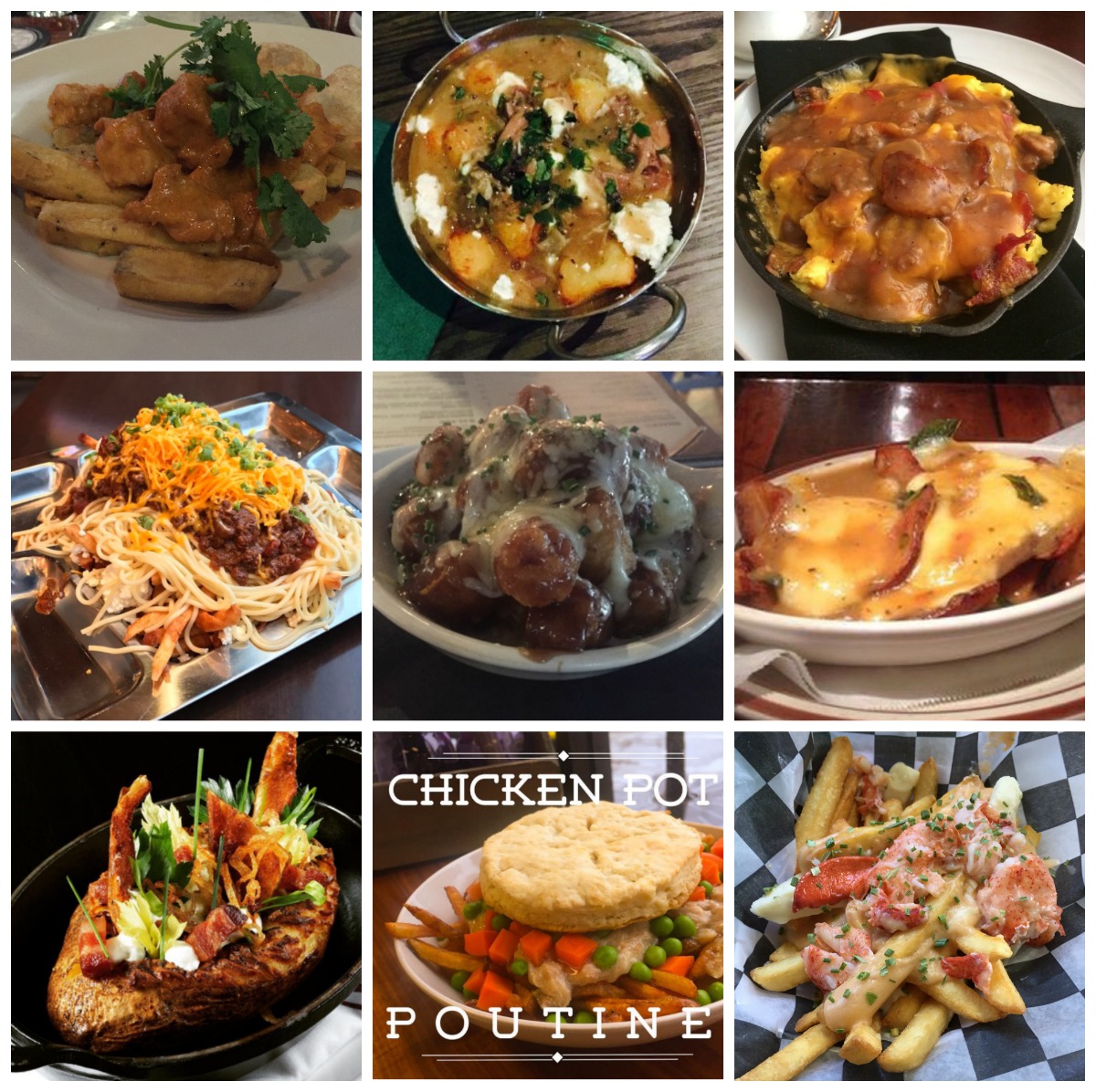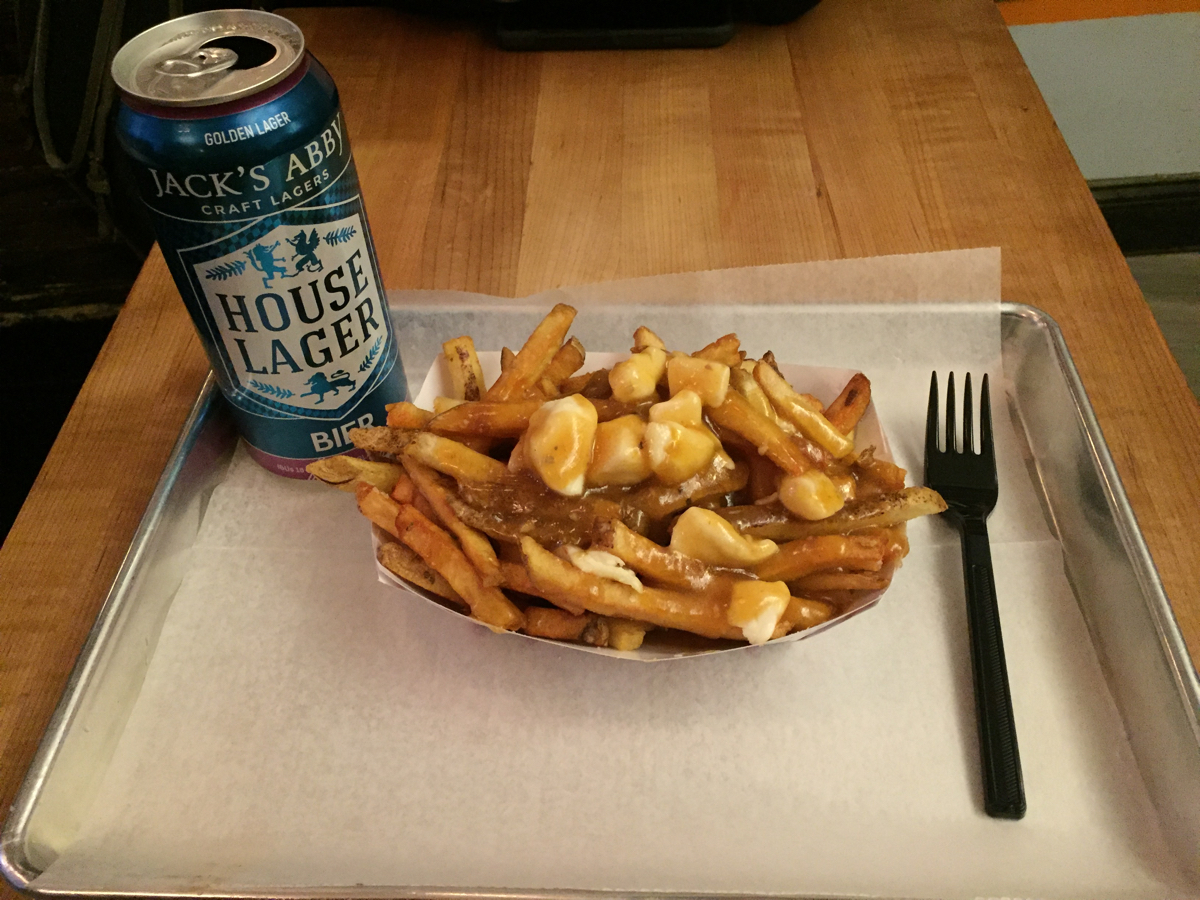Boston Has a Poutine Problem

Top row: Magoun’s Saloon photo by Spencer Buell, Glass House photo via Yelp, Parla photo via Yelp. Middle row: The Gallows photo via Instagram, Bostonia Public House photo by Spencer Buell, The Beehive photo via Yelp. Bottom row: Boston Chops photo via Instagram, Grub photo via Instagram, Fenway Park photo by Spencer Buell
It’s a cold Wednesday night in April, and I’m sitting at Olde Magoun’s Saloon, a great bar in Somerville, waiting for bad poutine.
One by one, the staff is delivering varieties of the French Canadian delicacy that I, a Canadian, love so dearly to diners all around me. From the looks of it, they seem satisfied. Except they don’t seem to understand that it’s not poutine they’re tucking into. More like riffs on poutine, or jokes at poutine’s expense. One is made “southern-style,” with sweet potato fries and ham gravy. Another has chorizo in it, and is soaked in ranchero sauce. For dessert, there are chocolate-drizzled cinnamon sugar churros, splayed out on a plate like some through-the-looking-glass nightmare version of poutine.
So it is poutine, according to a city where poutine has gone terribly, gravely wrong.
At a time when the dish’s popularity has exploded, Boston, for some reason, refuses to get it right. Look for it on menus in just about every corner of Greater Boston and you’ll find goofy names and odd ingredients, puddles of gravy, ladles of puzzling sauces, and horrific cheesy goo. It’s as if restaurants have collectively decided that poutine is just a mound of stuff with other stuff on it, so long as there is cheese somewhere. This isn’t cultural appropriation. It’s cultural barf.
After refusing for years to eat this crap, I’m finally giving in. So here I am at “Poutine Fusion” night at Magoun’s. Ground Zero.
“We can thank our neighbors to the North for many things including hockey, Canadian Bacon and William Shatner,” an ad for this evening of eating reads. Which, you’re damn right. “But one of our favorites is poutine! Brown gravy over French fries and cheese curds is a perfect comfort food! For the month of April, we present to you takes on this classic dish with 7 different poutine-inspired dishes including a dessert!”
Like a loving parent at their kid’s curling match, I take a deep breath and just hope they don’t disappoint me.
I pass on the “SOUTHERN FREE BIRD” and “PORKTASTIC,” and ask for the “INDIAN BUTTER CHICKEN,” made with chickpea fries, curry sauce, chicken chunks, and paneer cheese. Here it comes.
I don’t want to be mean to Magoun’s. In case it wasn’t clear, I really like Magoun’s and have for a long time. But folks, what happened over there once a week in April is exactly what I’m talking about here. The fry-like things were fine, the chicken was also fine, the curry was good. To be honest, from a pure enjoyment perspective, the dish was actually pretty OK. But you know what it wasn’t? It wasn’t poutine.
Here’s what poutine is: It’s good, hand-cut fries, cooked a little crispier than usual; it’s rich, handmade gravy; and it’s cheese curds so fresh they squeak when you bite into them. It’s simple, and simple is good.

The poutine at Saus is actually poutine. Photo by Spencer Buell
Poutine is Québécois slang for “mess.” Food historians tell us the dish came to life in the province at some point a half century ago, when fries and cheese were first combined in gooey matrimony, and, eventually, gravy was added to the mix. Its trajectory after that is complicated, and who, exactly, gets to claim ownership of it has been debated endlessly. A much-talked-about report that came out in May argues that because it’s now thought of as a Canadian dish, it has been divorced of its distinctly Québec roots—yet another overlooked French Canadian contribution to the culture, the thinking goes. As I was born among the Celtic buskers and Anne of Green Gables memorabilia of Prince Edward Island, and can’t claim French Canadian heritage, I guess I’m not a perfect spokesman for how things ought to be.
But from my years bouncing back and forth over the border, I know poutine is delicious, it’s pretty cheap, and I’ve found in adulthood that it’s best enjoyed in the wee hours of the morning. Saus, the Boston fries joint a short walk from Faneuil Hall, is a good benchmark by local standards. It’s got gravy that’s sort of too thin and cheese curds that don’t really melt and stretch the way they’re supposed to. But it’s tasty enough. And it’s poutine.
Buckle up, though, because it gets a lot worse. Here, in no particular order, is what poutine is not.
Soup
Order the poutine at Glass House in Kendall Square, and out will come a little bowl of lamb gravy with potato gnocchi sitting in it, alongside flecks of goat cheese. You can eat it with a spoon, or, I guess, you could grasp the bowl in your hands and pour it directly into your maw, because you have long ago lost your capacity for shame, and because nothing matters.
Eggs
The North End’s Parla once served an “Old Sport” brunch poutine, which is what you get if you ladle gravy on to scrambled eggs and hashbrowns. Why anyone would make this, let alone eat it, I have no idea. The only reason to eat poutine for brunch is you have a layover in Québec City, or you’re on day three of an epic Screech bender. And even then.
Spaghetti
The Gallows—which has a poutine on its menu made with, believe it or not, ricotta—has been churning out the dish in three varieties: simple, vegetarian, and “out of control.” That option is constantly changing as part of something it calls the “50 States of Poutine.” A recent iteration, for which the inspiration was the great state of Ohio, came topped with chili, a mound of shredded cheddar and… is that spaghetti? Buddy, that is freakin’ spaghetti. You shouldn’t need a Canadian to explain why that’s so wrong.
Tots
Bostonia Public House, a higher-end place on State Street, has the top-rated poutine in Boston, according to Trip Advisor. So you can imagine it’s the first thing curious poutine newbies will try when the time comes to give it a shot. But instead of fries, which is how poutine is made, Bostonia insists on serving its version with tater tots, the latest in a long, dumb line of kid foods that become food trends for no reason (looking at you, loaded milkshake Instagrammers of the world). Making poutine with tater tots is, if you ask me, like cramming lobster ravioli with macerated fish sticks, or slamming oysters with a palm-full of Dippin’ Dots and Mountain Dew.
I will say this about Bostonia Public House’s tater tot poutine: the gravy is dark and rich, and the tots are for sure better than your average cafeteria cylinder. But the kitchen had clearly forgone curds in favor of cheese gloop (more on that later). So as far as calorie-rich bar snacks go, it sailed right over an exceptionally low bar, food-wise. But it was, at best, a distant cousin of poutine, and not nearly the same thing.
They aren’t the only ones to make this mistake. Tater tot poutine has spread like a virus around here. The Lower Depths used to do something similar, along with Lulu’s, Roxy’s and a never-ending list of places. There are White Trash Poutine Tots at Bukowski Tavern (“WARNING: YOU WILL BE ADDICTED TO THESE!”, its menu screams) and an Irish Poutine at Paddy O’s, which is tots, corned beef, cabbage, and “a traditional cheesy parsley sauce.”
Why?
Goo
Beehive recently announced it’s making poutine available until 1 a.m. Sunday through Wednesday. That’s great! If you ask me, you haven’t actually had poutine until you’ve had it at 1, or even 4 or 5 a.m. But from what I’ve seen, their poutine looks alright sometimes, but can also end up becoming what’s essentially a sheet of coagulated cheese-gravy goo. Is this all it takes to please you people? Horizontal cheese? Just on and around things? The cheese in your poutine should be in curds, folks. Melty curds. If your poutine looks like this or this when you order it, send it back. Or flee.
A baked potato
Boston Chops has the gall to serve something called a Poutine Style Twice Baked “Loaded” Potato, which is, according to the Phantom Gourmet, “injected with housemade gravy.” Excuse me? Or, as my Canadian brethren would say, pardon? Load your potatoes with whatever you want, but just because there’s gravy “injected” in your food, don’t call it “poutine-style.” Gravy as an ingredient doesn’t make something poutine-style any more than pumping it full of tartar would make it Cape Cod-style. I’m telling you, Boston is one false step away from a poutine-style shake at Shake Shack.
Bisque
It’s hardly the only abomination to be served at a stadium—remember the meatball cone and the “Texas Snowball”?—but the moment I knew the poutine problem had reached the tipping point was this: the lobster poutine at Fenway Park. Here’s what Fenway Park’s lobster poutine is: regular ol’ ballpark French fries and a coating of thick pink bisque, which is hot, and cheese chunks and recently thawed lobster parts, which are ice cold.
Execution issues aside, think about the problems with the Fenway Park lobster poutine this way: Lobster bisque on poutine? How about I pour gravy all over lobster roll and see how you like it? What if, instead of lobster bisque, they replaced the gravy in the poutine with your beloved clam chowder, about which you’ve maintained a rivalry with wrong-headed Manhattanites for generations? Oh… wait.
“Chicken Pot Poutine”
Come on.

I tried the lobster poutine at Fenway Park with Tim Beaulieu, of the Franco-American Centre of New Hampshire. He liked it. Photo by Spencer Buell
The dispute among French Canadians over experimental poutine is not new—curmudgeons have been insisting on traditionalism for years—but it’s intensifying as the dish’s popularity grows.
A few weeks ago, I posed the Poutine Question to a Facebook group for French Canadians in Boston. Is what’s happening to poutine in this city OK? “It’s like they are trying to reinvent spaghetti!” one commenter, Sylvie Matte, wrote. “It is OK to do something different but if it is too different, you can not call a ‘poutine,'” wrote Marie-Josee Duquette, who is from Montréal and just published a book about her time in Boston called Une Québécoise à Boston. (For what it’s worth, she tried the poutine at the Beehive and liked it.) A French Canadian expert I spoke with, who did not want to be named, recommended we call Boston’s version of poutine “sloppy fries” instead.
Among those who think I’m being way too much of a pain about this, though, is Tim Beaulieu, a member of the Franco-American Centre of New Hampshire and organizer of the NH PoutineFest in Manchester. Over a couple conversations about the state of poutine around here, Beaulieu has been gently trying to get me to relax, and just let the Boston-ification of poutine happen. “Some people aren’t accepting of changes,” he says, referring to the handful of critics who’ve come after him on Facebook for allowing PoutineFest contestants to serve extravagances like pulled pork with their gravy, fries, and cheese—but also referring to me.
“It comes down to pride a little bit,” Beaulieu says. “It’s their thing. But at the same time this is America. It’s good to put your own spin on things and see if it works. Throw some things against the wall and see if it sticks.”
In mid-April, Beaulieu and I agreed to meet at Fenway Park, order a pair of those bisque-laden lobster poutines for $14.50 a pop, and talk it over. Digging in—he enjoys his, likening it to a kind of lobster roll in a bowl—I tell him I’m worried that poutine will become the next pizza, a canvas for high-end eateries and dives alike to heedlessly pepper with ahi tuna, buffalo chicken, and God knows what else. But he’s all in. He says French Canadian expats in New England, who by his telling have been too modest about their heritage, should be rejoicing that so many people in chowder country know what poutine is these days, and that they like a signature Canadian dish enough to give it a platform at the coolest restaurants in town. “It’s a good thing for us,” he says. “It’s good for the language, for the culture, for people with funny last names like mine. It’s a good thing.”
Basically, he believes there is room for both new and old, which is the attitude he brings to his festival. When the second-annual PoutineFest kicks off on Saturday, June 24, at Northeast Delta Dental Stadium, he says judges will be tasting both traditional and assuredly nontraditional varieties of poutine. He’s particularly excited about the prospects of the Smokey Bear Poutine from Grub, a new restaurant in Mission Hill that is among the first in Boston, alongside Saus, to claim it specializes in the dish. The ingredients of the Smokey Bear Poutine include smoked gouda, pulled pork, and maple syrup.
“It’s good,” Beaulieu says.
If only it were that simple.


